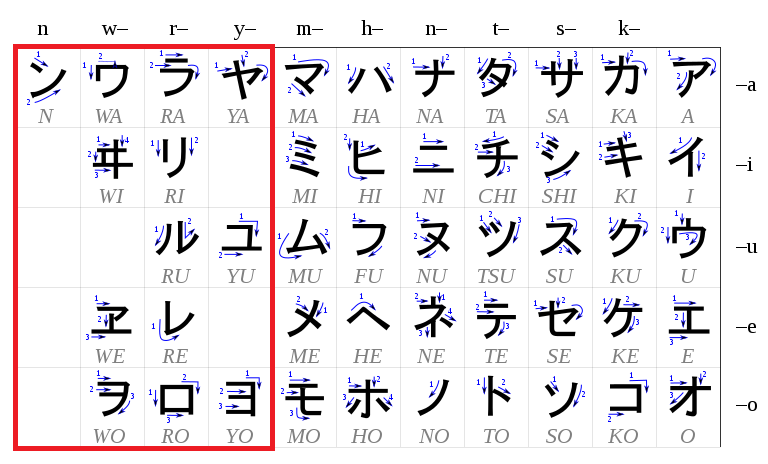Overview

Hello everyone! Today, we will look at the last 4 columns of the Katakana table, and we will also finally learn how to make all sorts of sounds with Katakana diphthongs!
Katakana (Eighth column)



Katakana (Ninth column)





Katakana (Last two columns)



Like in the Hiragana table, ヰ (Wi) and ヱ (We) are considered obsolete.
Diphthongs
Just like with Hiragana, diphthongs can be made by adding small versions of ヤ、ユ、ヨ next to consonants ending in ‘i’. For instance, you can have ジャイアント (Jaianto), meaning giant.
However, you can also add the small ヤ、ユ、ヨ next to any consonant in Katakana. This means that you can make words like デュエル (Dyueru), meaning duel.
Another main difference is that you can add small vowels next to any consonant, so you can make sounds like ディ (Di) and ファ (Fa).
These small vowel diphthongs can also be added to ウ , forming words with the ‘w’ sound, and to ヴ , forming words with the ‘v’ sound. For example, ウィ is read as ‘wi’ and ヴぁ is read as ‘va’.
Take note that some sounds overlap, like ワ and ウァ. In those cases, just choose the simpler ones, or those that use less letters.
Example words
- ジャイアント (Jaianto) – Giant
- デュエル (Dyueru) – Duel
- ファックス (Fakkusu) – Fax
- ディスプレイ (Disupurei) – Display
- ウェブサイト (Webusaito) – Website
- ウィキペディア (Wikipedia) – Wikipedia
- ボタン (Botan) – Button
- キリン (Kirin) – Giraffe
- チャーハン (Chaahan) – Fried rice
- アメリカ (Amerika) – America
- ヨーロッパ (Yooroppa) – Europe
- ロシア (Roshia) – Russia
- ルーレット (Ruuretto) – Roulette
- ヤンキー (Yankii) – Delinquent
- ユーフォー (Yuufoo) – UFO
Conclusion
Today, we have learnt the final four columns of the Katakana table, as well as diphthongs. Thanks to diphthongs, there are a lot of words that can be formed. Most of them are loaned words from English, so you should be able to understand them by reading them out. Others are loaned from other languages, for example チャーハン comes from Chinese, but a quick search with Google, or with dictionary apps like JED and Japanese Dictionary – Dict Box will tell you that it means fried rice.
But how do you type in Japanese? Well, that is what we will learn in the next lesson. Hope to see you there!

Good info. Lucky me I reach on your website by accident, I bookmarked it.